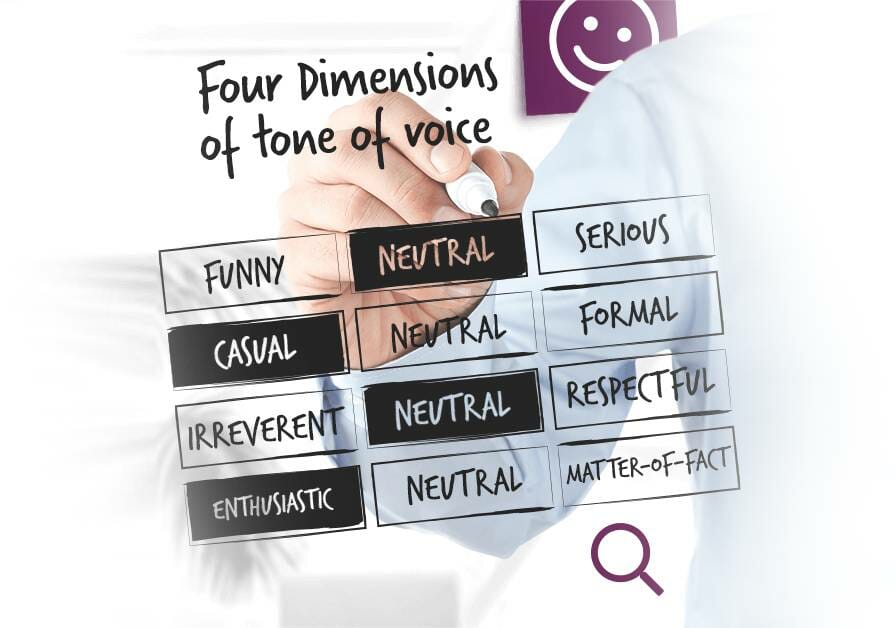Some products excel at communicating with users. One of the finest examples is Slack. The corporate communicator is known for its hilariously absurd wit. After stumbling upon such a well-written microcopy, decision-makers sometimes feel the urge to add similarly impressive UX writing to their own solutions. So, they start by hiring a UX writer (or more) and show them what kind of communication they’d like to have in their product.
However, that’s not an effective way to get good microcopy.
Unfortunately, before you add all the funny bits to your product, you need to do the tedious work – planning. If you skip it, even the wittiest microcopy won’t impress your users. Instead, it may irritate and anger. Worst case scenario, it could even push your clients into the welcoming arms of your competition.
Why? Let’s start with the fact that most products shouldn’t even be funny. But that’s just the tip of the iceberg.
Because before you write even one sentence or button message, you should first define your product’s tone of voice. In this article, I’ll tell you how to do it (and why) ⬇


But Why is Good UX Writing (and Microcopy) Even Important?
If the above question has popped into your mind after reading the intro, you should go through the previous article in this series before reading on. It explains what UX writing is, exactly, and why you shouldn’t sideline it.
UX Writing – Why Defining Your Product’s Tone of Voice is Pivotal
We like to think that communication is an intellectual activity. However, you probably have heard before that what you’re saying is often less important than how you’re saying it. A lot of research supports this claim. For example, a UCLA study showed that gestures account for 55% of the impact a speaker has on their audience. What’s more, the study also concluded that, overall, non-verbal elements of a presentation – like literally the tone of voice – account for 93% of the impression. Surprisingly, words only make up 7%.
If you’re a speechwriter, this statistic must be depressing.
But since we’re talking about writing for digital products, there’s some good news. With UX writing, you have control over both what you’re saying and how you’re saying it. The latter – determined by the tone of voice – non-verbally communicates how the speaker feels towards the reader. Importantly, it’s seen in every bit of content in your product – like in buttons, error pages, calls to action, and many, many more.
The impact of microcopy’s tone of voice is comparatively important to the speech’s non-verbal elements. Similarly, it has an enormous influence on the audience. For instance, it’s often pivotal in convincing your users or customers to perform certain actions – like buying something from your e-commerce store.
And this is by no means an exaggeration. A Nielsen Norman Group study explored how two different tone of voice versions of the same website impact user experience. Interestingly, respondents were unanimous in their decisions. For example, when it came to a hospital’s website, the test group preferred casual language over a formal tone. Although formality usually communicates confidence and trustworthiness, the casual tone was perceived as more friendly and trustworthy. The formal one was seen as “businesslike” and not very reassuring for a hospital.
As a result, the right tone of voice can make the difference between landing a one-time visitor and a loyal customer.
UX Writing – Defining the Tone of Voice
Having established how important the tone of voice is, let’s now discuss how to define it.
In 2016, Nielsen Norman Group defined a general tool for outlining simple tone profiles. Since then, the framework has been shared countless times by industry experts. Today, it’s somewhat of a market standard in setting up a tone of voice for UX writing.
According to the framework, the tone of any piece of content can be defined along 4 dimensions: formality, enthusiasm, respectfulness, and (yes) humour.
So, the same message can take different shapes and trigger diverse emotional reactions – all depending on the tone of voice.


With the framework, you can define each of the 4 dimensions from the perspective of two extremes:
- Formal vs casual: Is your writing formal, informal (neutral), or just casual?
- Enthusiastic vs matter of fact: Is the writing enthusiastic and emotional, or dry and matter of fact?
- Respectful vs irreverent: Is the writing respectful or irreverent? (Nielsen Norman Group notes that intentional irreverence is usually an effort to set the brand apart).
- Funny vs serious: Is the writing humorous or approached seriously?
Let’s analyze how this works in practice.
UX Writing Tone of Voice – Example
Imagine you’re writing a confirmation message saying that the user has successfully subscribed to a company newsletter.
A formal, matter of fact, serious, and respectful version of this message could sound like this:
You have successfully subscribed to the newsletter.
Sounds somewhat stiff, right? Let’s try to be a little more casual (and conversational):
Thank you for subscribing to the newsletter.
Now, if we add a little more enthusiasm, we’d probably end up with something like this:
It’s great to have you aboard! Thank you for subscribing to our newsletter!
And if we go to the very extreme, we could write a casual, enthusiastic, (hopefully) funny, and in-between respectful and irreverent (cheeky?) message like this:
Wow! Richard! RICHARD! We finally landed a new subscriber!
Ah, year, sorry – we got carried away! Thank you for becoming part of our reader family!
On the example of an error message, Nielsen Norman Group also presents how using the 4 dimensions can create very different effects. Take a look here:
UX Writing Tone of Voice – Context
Importantly, the UX writing tone of voice isn’t just a matter of preference. It should be aligned with your company’s image and branding. To be more precise, it should be a natural consequence of your brand personality.
For example, if you’re writing microcopy for a bank that promotes itself as a go-to place for teenagers (and gifts their young customers free party vouchers for setting up an account), being funny, casual, enthusiastic, and slightly irreverent may do the trick.
Like:
Hey! Aren’t you too young for that sort of thing?
Before we’ll start analyzing your investment inquiry, your legal guardian will have to okay this. Please don’t hate us. It’s the law.
[MORE INFO]
However, if we’re talking about a bank for the wealthy that invests millions of their hard-earned dollars, being goofy-funny and unrespectful may very well be a death wish.
Another quick example. We already mentioned the hospital website test (and how, surprisingly, users preferred a casual tone of voice). Yet, there’s a hard line you need to draw. Just imagine such an error message:
Oops! An error has occurred! But look on the bright side – at least you don’t have cancer! (Well, hopefully – after all, you’re on the website of the ENT department).
I must give myself a pat on the back. I think this error message is hilarious! However, I (REALLY) hope I don’t have to convince you that, if used, this could end up being the worst error message of all time*.
So, just to reiterate, your tone of voice should be a consequence of your brand personality – and should be adjusted to the context the user is in.
And remember: like in any UX-related area, the best way to get the answers – in this case, to find your tone of voice – is to test. What’s more, don’t forget that after you set up your tone of voice, you need to be consistent. If you decide to communicate in a serious way, you can’t start throwing around jokes willy-nilly on random subpages.
*Unless we’re talking about a borderline original clinic for hipster young people. Nope, still unacceptable.
UX Writing Tone of Voice – The Key to Successful Microcopy
Writing copy for your products isn’t limited to what you’re saying – but also concentrates on how you’re saying it.
By defining your tone of voice, you equip yourself with the framework for writing convincing microcopy.
And if you need help with establishing your tone of voice – or would like to outsource UX writing entirely – you can always entrust your project to design professionals. (Yup, I mean us. Call us. Or drop us a message in the contact form).





